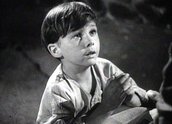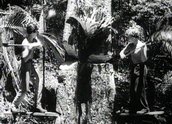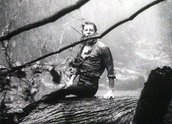


Sons of Matthew (1949)
Synopsis
Irishman Matthew O’Riordan (John O’Malley) and his English wife Jane (Thelma Scott) have carved a farm from fickle acres at Deep Creek, in northern New South Wales. They battle drought, flood and fire to raise five boys and two girls. When illness claims the life of a neighbouring woman, Jane takes in young Cathie McAllister (played as a baby by Charmian Young).
The O’Riordan boys grow up to be strong and ambitious young men. The eldest, Shane (Michael Pate), decides to take the advice of his uncle, Jack (John Fegan), and move into the virgin country to the north, where there is good land for those who can clear it. Shane leads his brothers and the now grown-up Cathie McAllister (Wendy Gibb) on the arduous journey into the mountainous south-east Queensland rainforest, where they start clearing and building a primitive log house. Cathie is expected to marry the second son Barney (Ken Wayne), but she realises that she loves Shane. As the farm becomes a reality, Shane tells Barney the truth – he loves Cathie and will do his best to take her away from him. At the same time Barney had been flirting with the pretty blonde in the little village below the mountain. The two men fight after a huge storm has almost wrecked the farm. Barney knocks Shane out, damaging his brother’s spine. While Shane recovers, Barney expunges his guilt by working as hard as two men. Shane regains the use of his legs and the O’Riordans prosper, with Shane and Cathie as husband and wife.
Curator’s notes
Sons of Matthew is a legendary film in the history of Australian cinema, partly because of the extraordinarily adverse conditions in which it was made. Charles Chauvel set off from Sydney in March 1946 with a convoy of trucks, aiming to make an epic tribute to the pioneering farmers of northern New South Wales and south-east Queensland, an area in which his own family had deep roots. Chauvel had been making films since 1926, and he was one of the few who managed to stay in production during the Second World War. He had had a popular success with Forty Thousand Horsemen in 1940, followed by The Rats of Tobruk in 1944, and those films helped him to raise money from the Australian arm of Universal Studios and Greater Union for Sons of Matthew. Chauvel was also able to enlist much cooperation from the Queensland Government, in provision of services and logistics.
Unfortunately, the elements were not subject to Chauvel’s great powers of persuasion. Even before they got to Queensland, the area was flooded. The cast and crew had to wait a week in hotels in Beaudesert, a very small town, before the Logan river allowed access to an old American army detention camp, their intended base for production and accommodation. Once there, the river rose behind them and stranded them in the camp. Chauvel and his crew of 70, including small children, could neither shoot film nor move out, and they began to run short of both food and clean water. The rain didn’t let up much during the next six months of filming. Maxwell Dunn, who worked with the Chauvels on the script, wrote later in his book How they Made Sons of Matthew that it was the wettest season in 80 years in Queensland – ‘in the next ten weeks 55 inches (1,400 mm) of rain fell’.
After six months, Chauvel returned to Sydney to shoot the studio sequences. Two months later, they went back on location, this time for another five months. This length of time was almost unheard of in giant Hollywood productions, let alone an Australian film. The two producers, Herc McIntyre of Universal and Norman Rydge of Greater Union, both visited the set and tried to persuade Chauvel to return to Sydney or shut the film down, but Sons of Matthew was an extremely personal film for Chauvel. It was about the people he grew up with – the descendants of the dogged settlers who opened up south-east Queensland to farming in the mid-to-late 19th century.
Chauvel was born in 1897 at his parents’ first property, 'Killaloe’, a part of South Canning Downs station. They began with just a small slab hut, six cows and a bull. The young Charles grew up a capable horseman and worked on cattle stations before going to Sydney to study art. His mother was the daughter of Henry Barnes, a founder of the Australian cattle industry. Sons of Matthew is as much a tribute to the women in these pioneering families as the men.
Even so, the original inspiration was a different source. In 1934, while on location for Heritage (1935), Chauvel had ridden to the top of the Lamington Plateau to a guesthouse established by the O’Reillys, the first family to settle in the extremely beautiful but inaccessible McPherson ranges, west of the Gold Coast. In 1937, Bernard O’Reilly became famous across Australia for finding the wreck of the Stinson, an aircraft that crashed on a commercial flight from Brisbane to Sydney. O’Reilly rescued two men who had survived ten days in the bush after the crash. Chauvel read his book Green Mountains (1940) while he was filming The Rats of Tobruk (1944) and decided to tell the story of his Stinson rescue. He combined this with elements of O’Reilly’s second book, Cullenbenbong (1944), about growing up in the Blue Mountains, west of Sydney. Maxwell Dunn says that the script, co-written by Charles Chauvel and his wife Elsa, went through many drafts before they dropped the Stinson rescue element, to concentrate on the story of the five brothers. In the end, much of the final script was also reworked, because of the weather problems.
Sons of Matthew eventually cost around £120,000 – more than twice the budget of other films being made at the time (such as Smithy, 1946). It took 18 months to complete, but it was a great success with Australian audiences, when it finally opened in December 1949 – almost four years after work began. The film ran 107 minutes, but Universal cut 30 minutes out, added some American narration and renamed it The Rugged O’Riordans for its UK and US release. Its returns were disappointing in both markets, which must have been a terrible blow for Chauvel.
The film is in many respects his most personal and ambitious work. Some critics believe it’s his best film – although others prefer Jedda (1955). It’s certainly an extremely vivid depiction of Chauvel’s great theme – the heroic conquest of the land by Australia’s white settlers. Chauvel’s fervent nationalism and his love of the epic possibilities of the medium combine to produce some of his most thrilling sequences. The film’s climax, during a cyclonic storm, is still a remarkably powerful recreation of the violence of nature. The influence of John Ford is obvious, but Sons of Matthew is a long way from being a transposed western. In postwar Australia, the film gave audiences still reeling from war-induced shortages a great sense of hope. It was a story of the national bounty – forests rich with timber, grazing lands that would yield fat cows and strong horses, and people who were young, virile and hardworking. Chauvel had always, to some extent, been a propagandist for Australia, even as he was a fervent admirer of Hollywood’s production skills. Sons of Matthew expresses a great sense of nationalist pride, but with the kind of red-blooded action sequences that Chauvel always strived to provide. It was even credited with helping to attract postwar migrants to Australia, through the film’s energetic publicity campaign in Britain.
- Overview
- Curator’s notes
- Video 3 clips
- Principal credits
- Find a copy
- Comments 1
- Map
- Add your review



